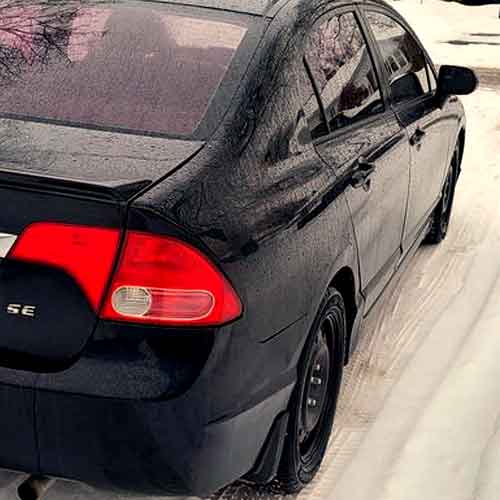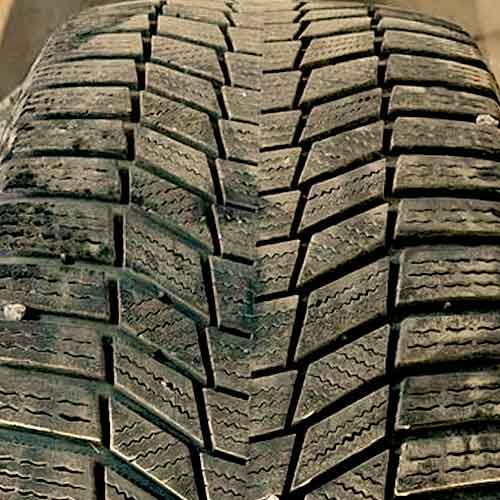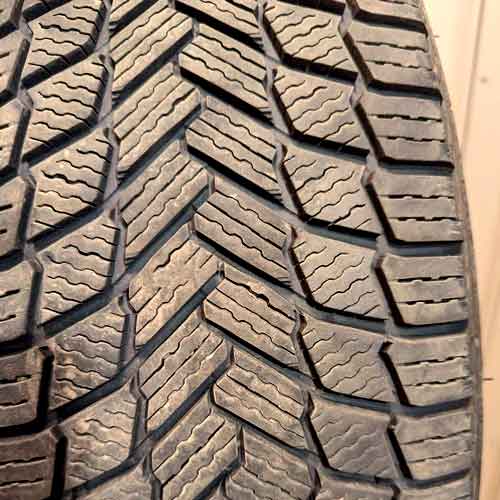Both Michelin X Ice Snow and Continental WinterContact SI are top performers in the winter tire market, each excelling in distinct aspects of traction, lifespan, and comfort, presenting various options to match diverse driver needs and road circumstances.

Table of Contents
Available Sizes
The Michelin X-Ice Snow (review) comes in 125 total sizes in 15 to 22 inches. They have following specs.
- Speed ratings: T and H.
- Load ratings: SL and XL.
- Tread depth: 10.5/32″ on all.
- Weight: 16 to 40 lbs.
- Tread warranty: 40k miles.
On the other side, the Continental WinterContact SI comes in 15 to 20″ with following.
- Speed ratings: H and T.
- Load ratings: XL only.
- Tread depth: 10/32″ on all.
- Weight: 15 to 36 lbs.
- Tread warranty: None.
Tread Pattern
Starting with the Continental WinterContact SI, the tire presents a truly unique pattern.

Here, a directional design can be observed, with the central-most area consisting of an uninterrupted rib composed of misaligned blocks that mirror leaves on a vine.
These lugs feature chamfered edges and deep, interlocking sipes.
The surrounding lugs echo similar tread features, albeit with a larger size and siping patterns oriented at different angles to enhance overall traction.
Together, these lugs form three ribs, resulting in four longitudinal grooves.
These grooves are interconnected by slanted lateral tread voids, promoting excellent self-cleaning capabilities.
The shoulder lugs are elongated and have wider lateral gaps, which, in turn, yield a longer siping pattern, albeit with a similar wave-like design.
It’s worth noting that, in contrast to the central blocks, the sharper edges of the shoulder blocks are not chamfered.
The Michelin X-Ice Snow, on the other side, also comes with a distinct directional tread pattern.

Here, 5 circumferential grooves are formed by four ribs, in the middle, (not counting the shoulders).
The central most section has blocks very closed up together. So tread voids there are pretty crowded up, though they still are inter-connected with each other.
Here blocks have a mixture of dual siping, rectilinear and interlocking patterns.
Moreover, you also see sharp off-set edges here, along with snow vices.
Going outwards, you see less aggressive rib, with squared off blocks.
And on shoulders, you see blocks with thickest of all sipes.
These blocks have the widest of all lateral grooves, and their edges there are also serrated.
Dry Performance
The efficacy of dry grip relies on the extent of the rubber’s contact with the surface, underpinned by two primary factors: directional grip and lateral traction.
Let’s discuss them both one after another.
Directional Grip
The effectiveness of the directional grip depends on the central tread area, which basically tells you about the rubber-to-road contact.
And given that the middle area bears the brunt of the weight when a tire rolls straight, Michelin X-Ice Snow, with its more packed up interlocking lugs there, ensure a superior, and uninterrupted surface contact, delivering better performance.
Although the WinterContact SI features a near-continuous running layer, it lacks the streamlined execution of its counterpart, resulting in an almost 9 feet longer braking distance.
Winner: Michelin X Ice.
Handling
Handling rests on the tire’s shoulder areas and overall weight. As the directional travel applies pressure on the central lugs, cornering shifts the weight towards the shoulders due to inertia. The capacity of these lugs to engage with the road significantly affects performance.
Michelin X-Ice Snow, with its closed shoulder lugs, offers superior performance in this respect. Conversely, the Continental WinterContact SI, aside from featuring broader grooves, also carries a heavier structure.
This additional weight causes increased flex in the tire’s lugs, resulting in diminished steering feedback and an imbalance between understeering and oversteering.
Winner: Michelin X Ice.
Ice Traction
Michelin X-Ice Snow indisputably commands icy terrains, significantly outshining its counterpart, in all, braking, acceleration, and handling tests.
So why is this the case?
Well this is because simply put, the tire feature more biters.
The Continental tire, with its larger tread voids and less abundant notches simply can’t grip on slippery ice as better as the Michelin.
The tire lacks some intricate features like dual and multi angled siping, which are highly needed on this packed up snowy terrain.
In contrast, Michelin X-Ice Snow presents superior biters.
It offers a more diverse collection of groove notches and snow vices oriented in both lateral directions, coupled with an ample supply of dual-patterned siping, providing better overall gripping efficacy.
Winner: Michelin X Ice.
Comfort Levels
The sum of ride comfort hinges on two aspects: the noise emitted and the tire’s capacity to mitigate road shocks.
Firstly, let’s delve into the noise factor.
Simply put, noise generation is a product of air particles striking the tread’s walls. And so this tells us, that larger tread gaps result in a noisier ride.
Consequently, the Michelin X-Ice Snow, due to its tightly-packed tread gaps, provides a superior ride in terms of noise levels.
Enhanced by its sophisticated pitch sequencing technology, the tread blocks’ slight geometric variance results in air particles creating disparate tones that effectively cancel each other out.
On the other hand, the Continental WinterContact SI excels in vibration damping, thanks to its relatively softer tread compound. This feature grants it a superior shock absorption ability, ensuring a more smooth and comfortable ride.
Winner: Both!
Snow Traction
On fluffy snow, hands down we have a clear winner, the Continental WinterContact.
Basically, the Michelin X-Ice Snow, featuring a more closed design with a continuous running rib in the center and absent interlocking grooves, lacks the ability to gather snow, offering its rival an edge.
The significance of snow gathering stems from the principle that snow adheres better to snow than to rubber.
And the Continental tire, with its wider tread voids, permits improved snow-to-snow contact, enabling its lug voids to retain fluffy snow particles within their interconnected grooves and snow vices.
Additionally, its pronounced directional pattern facilitates paddling, scooping snow backwards, and generating superior forward momentum.
Winner: Continental WinterContact SI
Wet Traction
Two primary elements steer wet traction: the tread design and the rubber compound utilized in the tire’s construction. These variables essentially dictate the tire’s grip on damp surfaces and its resistance to hydroplaning.
Let’s discuss each.
Wet Grip
Although both tires feature substantial siping, the Michelin X-Ice Snow edges ahead slightly in performance. It incorporates a more aggressive siping pattern, merging linear and interlocking slits.
Moreover, the generous number of biters on its tread allows for more effective gripping on wet surfaces.
These attributes give the Michelin tire a slight advantage in terms of grip. Sipes operate by expelling air, subsequently forming a vacuum that draws in water particles.
In this area, the Continental WinterContact, with its less efficient siping, trails its competitor.
Winner: Michelin X Ice.
Hydroplaning resistance
Hydroplaning, essentially a form of floating, occurs when water forms a thin layer between the tire tread and the road surface due to ineffective water dispersion. Wider grooves help to prevent this.
That’s why the Continental WinterContact SI excels in this area.
Its broad grooves and sweeping arms allow for higher average speeds without hydroplaning in both straight-line and curve aquaplaning tests.
Its interconnected groove system efficiently disperses water in all directions, delivering superb hydroplaning resistance.
Winner: Continental WinterContact SI
Summing Up
What key takeaways can we glean from this discussion? Well, quite a few!
In snowy terrains, particularly with fluffy snow, the Continental WinterContact SI distinguishes itself through its unique tread design. However, this same design restrains the tire’s performance on icy and wet surfaces.
Also, its wider grooves, while beneficial for snow scooping, reduce the tire’s effectiveness in terms of dry traction, albeit the difference between the two tires is marginal.
In terms of comfort, both tires match evenly, given that comfort depends on noise generation and vibration absorption capabilities.
The Continental tire performs better in the latter, whereas the Michelin X-Ice Snow emerges as the superior choice for overall road noise reduction.